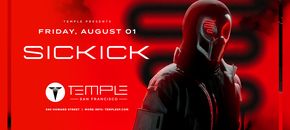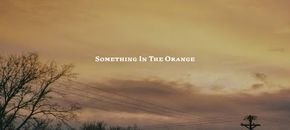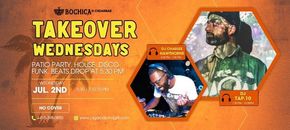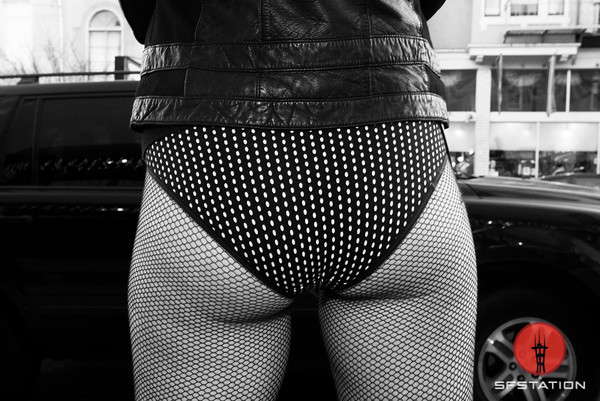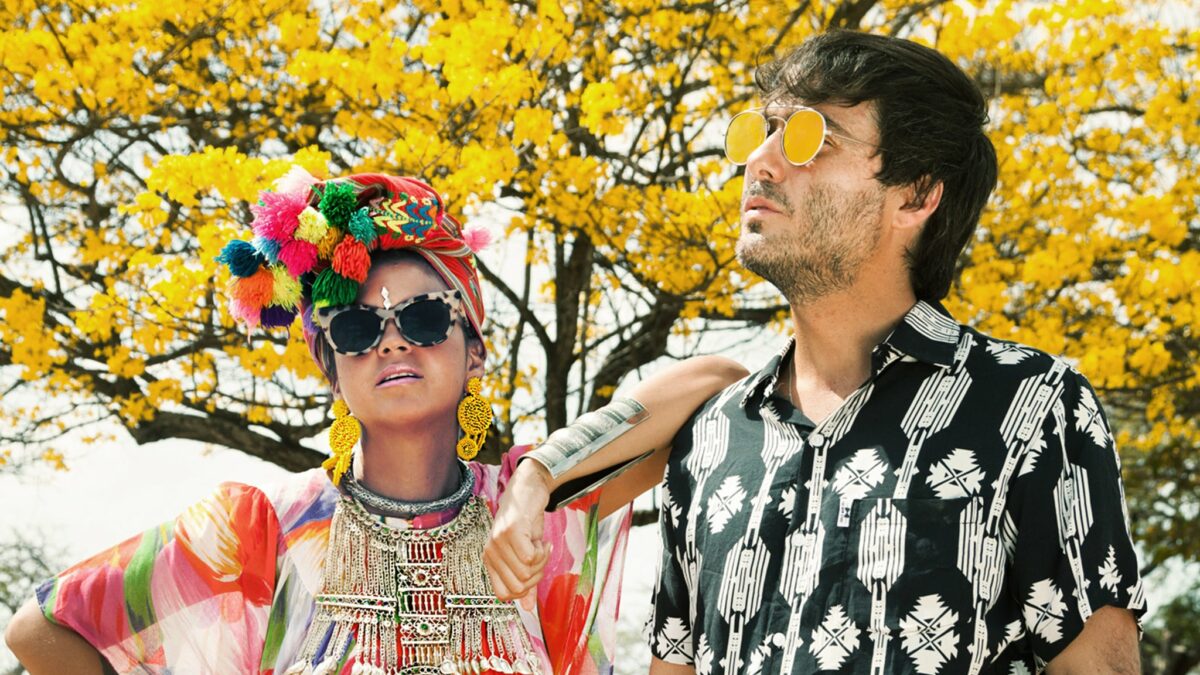Q&A: Beats Antique Discuss Touring, Twerking and Hanging Out With Robert Smith
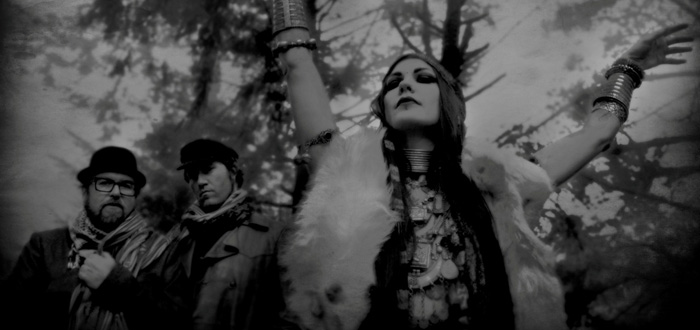
Beats Antique make worldly music, and amidst a nationwide tour supporting their new album, A Thousand Faces- Part One, they’ll finally settle down in San Francisco for two concerts on their home turf at the Fillmore on November 16th and 17th.
The members of Beats Antique have impressive credentials deeming them a worldly title. David Satori once traveled West Africa playing music after graduating from the California Institute of the Arts with a degree in music performance and composition. Zoe Jakes has more than 10 years of reputable dancing experience, blending belly dancing with tango, popping and Indian dance. Tommy Cappel, the son of two music teachers, studied New Orleans jazz and bebop drumming at the Berklee College of Music before trekking to San Francisco.
The trio serendipitously met, and the rest was history. What formed was a melting pot of incredible musicianship, passionate performance art and dance, and a desire to create unforgettable live shows. Call them electronic; call them worldly, at the end of the day they are just incredibly driven people pushing the envelope for artistic expression.
We caught up with the trio for a phone interview, hiding out in the green room at Fitzgerald’s in Houston, to talk about their current tour, their recently released theme album and twerking.
You’re currently on tour and making some amazing stops, including a show in New Orleans where you played with The Preservation Hall Jazz Band. How did that come about?
Tommy: One of the people in the jazz band is a fan and a friend; so they had us come out and do a little sit in set with them. We played some of their songs, and they played some of ours.
Zoe: We didn’t really know what we were walking into. We were just like “we’re gonna play this show in New Orleans” and it turned out to be one of the best shows to date. It was in this tiny room built in the 1700’s in the French Quarter with about 50 people.
David: We realized halfway through that Robert Smith [of the Cure] was in the audience. We got to hang out with him after we played. That was really cool.
What do you say to Robert Smith?
D: You just say nice things and let him do the talking. He wanted to sit in with us. I don’t know why he didn’t. He was really nice though.
T: And they (The Cure) are still amazing. We saw them play at the Voodoo Festival and his voice is still really good.
I’m always impressed with these musicians who seem to be timeless, like Robert Smith or Mick Jagger. It makes it a lot more pleasurable when you meet them, and they’re actually nice. You guys seem nice.
T: How are we gonna do this when we’re 60? We’re nice, we just got back from New Orleans where there is a celebration happening, so we’re a little tired.
How did you spend your Halloween?
T: We spent it in Minneapolis and had a big sold out show. Our opening band, Sorne, dressed up as us and did an amazing job. We battled on stage and had a big crazy dance party. We all wore Medusa heads.
Z: Our show is kind of like Halloween, so every night is like Halloween for us.
You are coming back home to the Bay ARea for two shows at the Fillmore, any special tricks (or treats) up yours sleeve?
T: Pretty much the show itself is a trick up our sleeve. It’s a pretty intense show with more stuff we’ve never done in front of any crowd. I think it will be well received.
Z: We also have guest performers. There’s a dance company joining us and adding beats.
D: Alam Khan is opening the second night and he’s on the album, so he’ll be joining us on stage.
Is there anything specifically you’re looking forward to being back home?
T: My bed. It’s not moving, which is nice.
Z: I’m at the point where I don’t really think about it too much anymore.
D: Getting to work on new music.
Your new album, A Thousand Faces-Part One, seems more refined, and yet more experimental at the same time.
T: Yeah, it was. The main thing being that we had a theme to it, and within that theme it called for different instruments and different tempos. We experimented a lot on this record, for sure.
D: This is our first concept album. We used Joseph Cambpell’s Hero with a Thousand Faces as structure and inspiration.
So you based the theme from a novel?
D: It’s not a novel. It’s more of a philosophy and psychology. He’s a psychologist and writer that came up with an idea that has to do with cross cultures. George Lucas and others have studied him for structure, and so we sort of used that same abstract structure.
T: It was actually really fun. We had a good time coming up with themes and stuff. It’s basically like a structure, but there’s a couple graphics available online, and people laid it out in chapters on a circle. We took each chapter and made a song for it, and just figured out what kind of adventure we wanted. We were given assignments on how to figure out and translate these parts. We also knew it was going to have a lot of video concepts and production, and a whole dance performance. We were actually able to create the show as we created the album.
Z: Everything happened together. It was the most cohesive project we’ve ever worked on. From the dance, to the visuals, to the music, everything came together when we recorded it.
How long did this take?
T: About six months.
Z: But we’d been talking about it since last January.
You teamed up with Les Claypool on the track “Beezlebub.” How did that collaboration come about?
D: Our previous band, Yard Dogs Road Show, went on tour with him. When we were on tour he said he’d love to collaborate. We decided it was time and wrote the song. He added the bass, vocals and lyrics.
T: Les is a big inspiration to our music.
How important is live tracking and instrumentation in your music?
T: It’s probably 90 percent live, which is the funny part. We write it on the computer with midi controllers, but then get the string players and have them perform, and the rest we play ourselves. The next album we have a 50-piece San Francisco orchestra that we recorded in our studio. Part two is actually being performed live, so the show will be act one and act two together. The album will drop in the spring.
You guys have played the Burning Man decompression, Bumbershoot and Sea of Dreams. Is there any particular festival you’d love to play?
T: One of them I was really excited about we just played—the Voodoo Festival in New Orleans. We had a great time closing out on Sunday right before Bassnectar and the Cure. That was one of New Orleans’s biggest festivals around Halloween. I’d like to play some jazz festivals, like the Newport festival. I think it would be fun to tap into that. We’ve played some folk festivals and that’s always really fun because we’re like that weird electronic band.
Zoe, as a professional dancer what are your thoughts on twerking?
Z: Are we talking about Miley Cyrus’s version, or actual twerking? I feel like Miley did not twerk. She just ran out there and stuck her tongue out. Actual twerking bounces around all this stuff, and it’s been around for a while. It’s a cultural thing and it’s cool to see dancers like Big Freedia come out and do this bouncing, booty dancing. I’m excited to see it surface because it’s exciting, but I do want to say for the record: Miley Cyrus was not twerking. She was jiggling around with her tongue sticking out, but it’s nice that she tried and exposed it.
D: Diplo and Major Lazer are one of the biggest supporters of twerking. He’s a twerk tweeter. We actually had some twerking on stage in New Orleans with Katy Red, and there’s a band called Hottub from Oakland that we did a song with in 2012. There’s a very twerkable line, “tippy tippy toes on a hot skillet.” The song is called, “Came to get Down.”
So you guys could be accredited for this Twerking phenomenon?
D: We could very well be responsible for it.
Beats antique perform at the Fillmore on November 16th and 17th.
